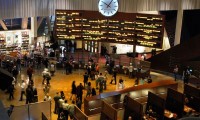BONNIE & CLYDE saved its most idiotic inspiration for the end. Up until its last few minutes, the second half of the Lifetime/A&E/History miniseries was perhaps marginally better than its first (which we dealt with in yesterday’s review). There was less chatty posthumous narration from Clyde (Emile Hirsch) this time around, a greater role for William Hurt’s laconic lawman, and a well-judged supporting performance by Sarah Hyland as Clyde’s unhappy sister-in-law (the Estelle Parsons role in the 1967 film). Then, however, crazy time set in, as the script by John Rice and Joe Batteer took the truly bizarre position that the deaths of Bonnie & Clyde were actually suicide by cop–that Clyde, overcome at his realization of Bonnie’s (Holliday Grainger) sociopathic tendencies after she gunned down a cop on Easter Sunday, deliberately steered them into a police ambush so that their bloody saga could end in a big way. To put it mildly, there’s no historical justification for this theory, and while art has had, since Shakespeare’s time and before, the right to adjust history in order to make a statement, the only one being made here was more of the same sentimentalized nonsense that had ruined this project from the beginning. Somewhere, Clyde Barrow’s body spins in its grave to have been abused so badly for the sake of a dumb movie.
Although the mood was more somber in Part 2, silliness still ran rampant. Clyde had premonitory visions of a menacing bunny rabbit (if only he’d lived to see Donnie Darko!), Bonnie nurtured her black-and-white fantasies of being a ballerina (which somehow became part of Clyde’s visions–don’t ask), and the pair’s crime spree was presented through anachronistic music montages. The action mostly alternated between chase scenes and shootouts–one sequence, in which the police attacked them at a motel, was baldly (and badly) restaged from Michael Mann’s Public Enemies–with occasional times out for Holly Hunter and Dale Dickey to look grim as, respectively, Bonnie’s and Clyde’s mothers. The script both exploited and condemned Bonnie’s pre-social media yen for public attention (the glamor photos she posed for were featured heavily, but Hurt’s cop got in a final shot at Elisabeth Reaser’s reporter so we’d know that giving publicity to criminals is bad, bad).
Grainger, even after she’d been hunted down by the police and burned in a car crash, looked unfailingly spiffy and worked hard to keep her southern accent going, while Hirsch mostly seemed like he wished he’d taken that left turn at Albuquerque; it was never possible to believe in their supposedly torrential relationship. Director Bruce Beresford, wisely, didn’t try to compete too strongly with memories of Arthur Penn’s legendary final sequence, keeping the cameras mostly on reaction shots of the lawmen rather than on Bonnie and Clyde being riddled with gunfire. Beyond that, he did a credible job of keeping the film in motion.
Early ratings for Part 1 of Bonnie & Clyde were unimpressive, given that it was airing on three substantial networks at once; perhaps next time, the multi-network brain trust will start with a script that’s worth producing.




